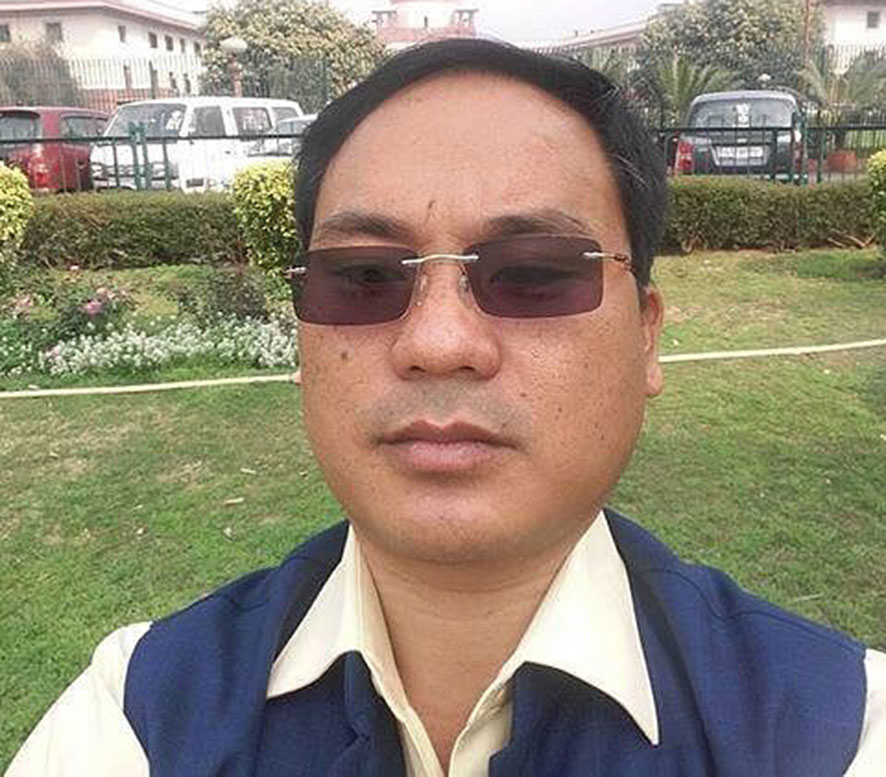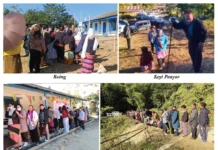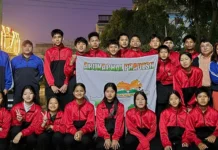Absolom Rockwang and James Kiwang still out of NIA’s reach
[ Tongam Rina ]
ITANAGAR, Jan 28: The National Investigation Agency (NIA) has filed a charge-sheet against four NSCN (IM) operatives in the Khonsa massacre case, in which 11 people, including MLA Tirong Aboh, were killed on 21 May last year.
The charge-sheet, which was filed before the NIA special court in Yupia on 27 January, named Luckin Mashangva, Jai Kishan Sharma, Yangte Josaham and Napong Jenpi @ Jenpi. The four are currently lodged in the Jully (Jullang) central jail.
They have been booked under Sections 120 B, 302, 307 & 34 of the IPC, Sections 25 (1B) (a) and 27 of the Arms Act, and Sections 16, 18 and 20 of the UA (P) Act.
In a statement, the NIA said, “Investigation has established that members of the terrorist group of NSCN (IM) conspired to commit the terrorist act of killing of Tirong Aboh, MLA Khonsa and 10 others. Investigation further established that the terrorist act was a result of larger conspiracy due to opposition by MLA, Khonsa of anti-development and extortion activities of NSCN (IM) in Tirap district.”
It said investigation revealed that members of the NSCN (IM), led by major general Absolom Rockwang (who is absconding) along with the four charge-sheeted, formed a terrorist group which was financed by one Jai Kishan Sharma.
The NIA had registered cases against them on 10 June, based on an FIR filed on 21 May at the Khonsa police station.
The NIA said the investigation is continuing.
The missing link between NIA investigation and Khonsa massacre
Even though the NIA has filed the charge-sheet after it took over the case in June last year, the key NSCN (IM) leaders in Arunachal remain out of the NIA’s radar.
The main NSCN (IM) leaders in Arunachal are its operation commander for Tirap, Changlang and Longding, major general Absolom Rockwang, and kilonser James Kiwang of the outfit’s civil wing, who is a Myanmarese national but settled in Tirap.
In August last year, the NIA had released posters of six NSCN (IM) operatives along with cash rewards, seeking information. The agency had named lieutenant colonel Apem, of Tizit in Nagaland, captain Ellie Ketok, of Kheti village in Tirap district, kilonser Ravi Wangno, a resident of Dadam village in Tirap, major general Absolon Rockwang, of Phatang village in Ukhrul, Manipur, captain Victor Tangkhul, of Ukhrul district in Manipur, and James Kiwang, of Myanmar.
Police sources say that Absolom Rockwang was one of the main persons behind the assassination of former MP Wangcha Rajkumar, who was killed in Deomali on 23 December, 2007, while he was playing badminton.
Rockwang was out on bail when the Khonsa massacre was carried out.
Sources say that Rockwang and James Kiwang are currently in Myanmar. However, when contacted, the NIA refused to confirm their whereabouts, stating that the investigation is still an ongoing process.
Eli Ketok is in NIA custody but his name is conspicuously absent from the list of those who have been charge-sheeted. He was arrested in October last year from Mon, in Nagaland, by security forces. He is known for terrorizing the people and government employees of Tirap.
Jalley Anna, a worker of Tirong Aboh who was tortured to death in March last year while the election campaign was at its peak, had identified Ketok and other NSCN operatives as his assaulters just before he passed away.
The state police and security forces had failed to arrest Ketok, even though he is known to have stayed on in the district even after Anna had been tortured to death.
Another prominent name missing from the NIA’s list is of Anok Wangsa, the NSCN (IM)’s area commander of Longding, Charaideo in Assam, and Mon in Nagaland.
Wangsa, a deputy to Absolom Rockwang, was arrested in July last year from Tizit, in Mon district of in Nagaland, with arms and cash.
Wangsa was in custody of the Assam Police, but is out on bail in a case not related to the massacre.
It is rather curious that the deputy of Absolom Rockwang is out on bail and not a person of interest to the NIA in the Khonsa massacre. NIA officials say that his role has to be investigated without giving further details.
NIA acting with impunity: NSCN (IM)
Meanwhile, on the day the NIA filed the charge-sheet, the NSCN (IM) in a press statement sent to this daily, among other things accused the Indian government of not restraining the NIA, saying that “the agency has taken recourse to India’s law and order against the NSCN who is having political dialogue with the GoI.”
The statement read: “The NIA has been acting with impunity and intensified its activities particularly after the ultimatum served by the GoI interlocutor in July, 2019 and the deliberate rejection of the framework agreement principle wherein the sovereign rights of the Naga people to use its national flag and constitution has been officially acknowledged.
“The unrestrained excessive activities of NIA will certainly reverse the clock back towards the pre-ceasefire period which witnessed intensive militarization, violent conflict and serious violation of human rights. The situation will certainly go out of control if the GoI does not take corrective measures in the true spirit of the ongoing political dialogue between and GoI and the NSCN,” it said.
The NSCN further said that “of late the activities of GoI intelligence agencies, particularly the NIA has definitely created trust deficit in the minds of the Nagas and the NSCN. We doubt the sincerity of the GoI in concluding an acceptable and honorable political solution considering its ‘carrot and stick’ policy. It is only when the GoI starts respecting its commitment, not otherwise, can the political dialogue move forward in the spirit of mutual trust and understanding.”
Botched police investigation and Army’s photo op
Less than 10 days after the Army and other security agencies, including the Arunachal Pradesh Police, had launched a search operation following the massacre, it wound up the search operation.
The search operation was launched on 22 May, a day after the massacre, but was concluded on 29 May.
Defence sources had confirmed to this daily that the search operation had been called off on 29 May, but on the same day the defence spokesperson said the operation had been intensified, and that a joint operation with the police and the civil administration was ongoing, adding that 11 people had been handed over to the state police for questioning.
In the meantime, the security agencies released a photo of the Indian Army and others in action, making it amply known to the NSCN and others where it was carrying out its operation.
When this reporter visited the district after the massacre, many said that the NSCN (IM) operatives had stayed on for three days after the massacre while the state police and the Assam Rifles carried out their internal strife.
Reportedly, the Assam Rifles had refused to carry out search operations in key areas identified by the state police some three days after the massacre. The lack of coordination and the reluctance among the search teams were out in the open.
On the day the assassination occurred, there were no search operations and the international borders were not sealed, insiders say.
The then DGP, SBK Singh, did not visit the district even after three weeks of the massacre. He was subsequently transferred out of the state in July last year.
Singh, who was in charge of the safety and security of the people, had told this daily that the police were not to be entirely blamed for the intelligence failure.
As it emerged later, the state police and the Election Commission of India (ECI) had not taken requisite security measures for Tirong Aboh despite his repeated verbal appeals. During a massive protest rally in Khonsa at the end of March against the killing of Jalley Anna, Aboh had directly made an appeal to the ECI to provide security.
He had also requested the ECI to provide security to ensure a free and fair election.
Aboh, a sitting MLA who was constantly under threat from the NSCN (IM) and who had lost a worker in Jalley Anna, had only four security officers – a reflection of the failure of the state police and central and state intelligence agencies.
The security in Tirap had been withdrawn after the election but prior to the declaration of the result. The state police and the IRBn were withdrawn from the district as they had to be deployed in Kra Daadi and Kurung Kumey districts from where repeated incidents of violence were being reported.
Those who were killed along with 47-year-old Tirong Aboh on 21 May included his workers and close relatives Wangngoi Hakhun (35), Jalin Hakhun (33), Wangngu Hakhun (30), Gamwang Hakhun (28), all from the same family, teacher Tangro Atoa (47), PSOs Poanhang Agi (38) and Khundong Siksa (50), driver Patwang Sumpa (20), Aboh’s son Along, and nephew Matlam.
Along and Matlam were 20-year-old college students.
Wangdan Hakhun (26) and Wangsen Hakhun (32) were injured and had to undergo long medical treatment outside the state.
PSO Nokliam Tekwa and a worker in the Aboh household, Nyajut Hakhun, escaped the massacre unhurt.
Aboh won the Khonsa West seat against his BJP rival by more than a thousand votes. The result was declared two days after he was assassinated.




